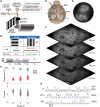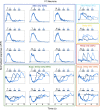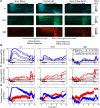Distinct roles of visual, parietal, and frontal motor cortices in memory-guided sensorimotor decisions
- PMID: 27490481
- PMCID: PMC4974053
- DOI: 10.7554/eLife.13764
Distinct roles of visual, parietal, and frontal motor cortices in memory-guided sensorimotor decisions
Abstract
Mapping specific sensory features to future motor actions is a crucial capability of mammalian nervous systems. We investigated the role of visual (V1), posterior parietal (PPC), and frontal motor (fMC) cortices for sensorimotor mapping in mice during performance of a memory-guided visual discrimination task. Large-scale calcium imaging revealed that V1, PPC, and fMC neurons exhibited heterogeneous responses spanning all task epochs (stimulus, delay, response). Population analyses demonstrated unique encoding of stimulus identity and behavioral choice information across regions, with V1 encoding stimulus, fMC encoding choice even early in the trial, and PPC multiplexing the two variables. Optogenetic inhibition during behavior revealed that all regions were necessary during the stimulus epoch, but only fMC was required during the delay and response epochs. Stimulus identity can thus be rapidly transformed into behavioral choice, requiring V1, PPC, and fMC during the transformation period, but only fMC for maintaining the choice in memory prior to execution.
Keywords: decision making; mouse; multiphoton microscopy; neuroscience; optogenetics; short-term memory.
Conflict of interest statement
The authors declare that no competing interests exist.
Figures




















References
Publication types
MeSH terms
Grants and funding
LinkOut - more resources
Full Text Sources
Other Literature Sources
Medical
Molecular Biology Databases

